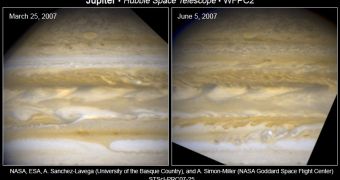It seems the giant of our solar system is full of surprises. NASA's Hubble Space Telescope took some astonishing pictures of the dramatic atmospheric changes on the planets, the like of which were never seen before.
The planet already had some unique atmospheric features, like the high-altitude clouds and a haze at the planet's south pole, or the "Great Red Spot," a persistent anticyclonic storm located 22 degrees south of the equator that is larger than Earth.
Now, the huge turbulent clouds covering the gas giant are rapidly changing as they encounter atmospheric disturbances and are speeding across the planet at hundreds of miles per hour. Hubble took pictures of massive transformations in the shape and color of the clouds in an area near its equator that became prominent of the entire surface.
Yellow, white and brown bands of clouds are wrapping the planet, caused by the atmosphere flowing in different directions at various latitudes. The interaction between dark regions, where the atmosphere falls and lighter ones, where it rises, create powerful storms.
The keen eye of Hubble captured these impressive color changes, showing that entire bands became lighter-hued and transformed into areas, while darker areas turned into belts. In the images sent to Earth, a thin band of white clouds above the equator is clearly visible in the left, which rapidly turned brown in the right image, probably to a merger of the entire initial band with the one below it.
Also in the left-hand image, the small swirls in the same band transformed into larger, undulating features in the right-hand picture, while the brownish upside-down shark fin completely disappeared in the right-hand photo.
Never before have such global upheavals been seen in a sharp resolution, like the one provided by the Hubble Space Telescope, so these images are very important for astronomers searching to understand how these global events occur on Jupiter.

 14 DAY TRIAL //
14 DAY TRIAL //